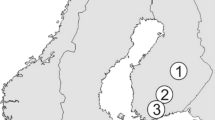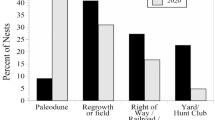Abstract
Arctic Alaska is an important breeding ground for many migratory bird populations. A variety of factors associated with industrial development may impact nesting birds in this region, including increased nest predator populations associated with anthropogenic nesting and perching sites and the availability of anthropogenic food sources. We tested the indirect impact of oil development on nest survivorship in an artificial nest experiment at Prudhoe Bay, Alaska, 2012–2014, by establishing and monitoring 268 artificial shorebird nests and 221 artificial waterfowl nests and through monitoring of real shorebird nests (n = 186). Distance to infrastructure and roads, and area of infrastructure within 2 km2 of the nest did not significantly affect nest survival of artificial or real nests. Artificial nest survival was higher at shorebird than waterfowl nests. Cameras deployed at a subset of artificial shorebird nests documented nest predation by Arctic fox (Alopex lagopus), red fox (Vulpes vulpes), parasitic jaegers (Stercorarius parasiticus), pomarine jaegers (Stercorarius pomarinus), long-tailed jaegers (Stercorarius longicaudus), northern harriers (Circus cyaneus), and glaucous gulls (Larus hyperboreus). The presence of a camera had a positive effect on artificial shorebird nest survival, possibly due to cameras being placed on progressively older nests throughout the season. In conclusion, we did not detect an effect from infrastructure on nest survival at the scale of the study, in either real or artificial nests. We suggest caution when using artificial nests for Arctic research, given differences in survival of real and artificial nests in this study, and potential differences in nest predators.




Similar content being viewed by others
References
Alaska Shorebird Group (2008) Alaska Shorebird Conservation Plan, version II. Alaska Shorebird Group, Anchorage
Anderson BA, Johnson CB, Cooper BA, Smith LN, Stickney AA (1999) Habitat associations of nesting spectacled eiders on the Arctic Coastal Plain of Alaska. In: Goudie RI, Peterson MR, Robertson GJ (eds.) Behavior and ecology of sea ducks. Canadian Wildlife Service Occasional Paper, pp 27–59
Andres BA, Smith PA, Morrison RIG, Gratto-Trevor CL, Brown SC, Friis CA (2012) Population estimates of North American shorebirds, 2012. Wader Study Group Bull 119:178–194
Bart J, Platte RM, Andres B, Brown S, Johnson JA, Larned W (2013) Importance of the National Petroleum Reserve-Alaska for aquatic birds. Conserv Biol 27:1304–1312
Bentzen RL, Powell AN, Suydam RS (2008) Factors influencing nesting success of King Eiders on Northern Alaska’s coastal plain. J Wildl Manag 72:1781–1789
Bêty J, Gauthier G, Giroux J-F, Korpimäki E (2001) Are goose nesting success and lemming cycles linked? Interplay between nest density and predators. Oikos 93:388–400
Buler JJ, Hamilton R (2000) Predation of natural and artificial nests in a southern pine forest. Auk 117:739–747
Burke DM, Elliott K, Moore L, Dunford W, Nol E, Phillips J, Holmes S, Freemark K (2004) Patterns of nest predation on artificial and natural nests in forests. Conserv Biol 18:381–388
Butler MA, Rotella JJ (1998) Validity of using artificial nests to assess duck-nest success. J Wildl Manag 62: 163–171
Derksen DV, Weller MW, Eldridge WD (1979) Distributional ecology of geese molting near Teshekpuk Lake, National Petroleum Reserve- Alaska. In: Jarvis RL, Bartonek JC (eds) Management and biology of Pacific Flyway geese: a symposium. Oregon State University, pp 189–207
Dinsmore SJ, White GC, Knopf FL (2002) Advanced techniques for modeling avian nest survival. Ecology 83:3476–3488
Eberhardt LE, Hanson WC, Bengtson JL, Garrott RA, Hanson EE (1982) Arctic fox home range characteristics in an oil-development area. J Wildl Manag 46:183–190
King DI, DeGraaf RM, Griffin CR, Maier TJ (1999) Do predation rates on artificial nests accurately reflect predation rates on natural bird nests? J Field Orn 70:257–262
Liebezeit JR, Zack SW (2008) Point counts underestimate the importance of Arctic foxes as avian nest predators: Evidence from remote video cameras in Arctic Alaskan oil fields. Arctic 61:153–161
Liebezeit JR, Kendall SJ, Brown S, Johnson CB, Martin P, Mcdonald TL, Payer DC, ReaCL, Streever B, Wildman AM, Zack S (2009) Influence of human development and predators on nest survival of tundra birds, Arctic Coastal Plain, Alaska. Ecol App 19:1628–1644
Liebezeit JR, White GC, Zack S (2011) Breeding ecology of birds at Teshekpuk Lake: A key habitat site on the Arctic coastal plain of Alaska. Arctic 64:32–44
Maier TJ, DeGraaf RM (2000) Predation on Japanese quail vs. house sparrow eggs in artificial nests: Small eggs reveal small predators. Condor 102:325–332
McKinnon L, Bêty J (2009) Effect of camera monitoring on survival rates of High-Arctic shorebird nests. J Field Orn 80:280–288
McKinnon L, Smith PA, Nol E, Martin JL, Doyle FI, Abraham KF, Gilchrist HG, Morrison RIG, Bêty J (2010) Lower predation risk for migratory birds at high latitudes. Science 327:326–327
Morrison RIG, McCaffery BJ, Gill RE, Skagen SK, Jones SL, Page GW, Gratto-Trevor CL, Andres BA (2006) Population estimates of North American shorebirds, 2006. Wader Study Group Bull 111:67–85
National Research Council (NRC) (2003) Cumulative environmental effects of oil and gas activities on Alaska’s North Slope. The National Academies Press, Washington D.C
Nguyen LP, Abraham KF, Nol E (2006) Influence of Arctic terns on survival of artificial and natural semipalmated plover nests. Waterbirds 29:100–104
Ortega CP, Ortega JC, Rapp CA, Backensto SA (1998) Validating the use of artificial nests in predation experiments. J Wildl Manag 62:925–932
Pamplin WL (1986) Cooperative efforts to halt population declines of geese nesting on Alaska’s Yukon-Kuskokwim Delta. Transactions of the 51″ North American Wildlife and Natural Resources Conference
Pärt T, Wretenberg J (2002) Do artificial nests reveal relative nest predation risk for real nests? J Avian Biol 33:39–46
Renfrew RB, Ribic CA (2003) Grassland passerine nest predators near pasture edges identified on videotape. Auk 120:371–383
Richardson TW, Gardali T, Jenkins SH (2009) Review and meta-analysis of camera effects on avian nest success. J Wildl Manag 73:287–293
Schamel D (1977) Breeding of the common eider (Somateria mollissima) on the Beaufort Sea Coast of Alaska. Condor 79:478–485
Smith PA (2009) Variation in Shorebird Nest Survival: Proximate Pressures and Ultimate Constraints. Dissertation. Carleton University
Stehn RA, Dau CP, Conant B, Butler WI (1993) Decline of Spectacled Eiders nesting in western Alaska. Arctic 46:264–277
Stickney AA, Obritschkewitsch T, Burgess RM (2014) Shifts in fox den occupancy in the greater Prudhoe Bay Area, Alaska. Arctic 67:196–202
Thompson FR, Burhans DE (2004) Differences in predators of artificial and real songbird nests: Evidence of bias in artificial nest studies. Conserv Biol 18:373–380
Thompson FR, Dijak W, Burhans DE (1999) Video identification of predators at songbird nests in old fields. Auk 116:259–264
Troy, DM (1993) Population dynamics of birds in the Pt. McIntyre Reference Area: 1981–1992. Unpublished report to BP Exploration (Alaska), Inc., Anchorage, Alaska, USA, prepared by Troy Ecological Research Associates, Anchorage, Alaska, USA.
White GC, Burnham KP (1999) Program MARK: survival estimation from populations of marked animals. Bird Study 46:120–139
Wiley RH, Lee DS (1999) Parasitic Jaeger (Stercorarius parasiticus). The Birds of North America Online (A. Poole A, ed.), Cornell Lab of Ornithology. http://bna.birds.cornell.edu/bna/species/445. Accessed 2 Feb 2016
Acknowledgements
We thank BP Exploration, Alaska, Inc. for their generous help with our field logistics. This project would not have been possible without assistance from the National Fish and Wildlife Foundation (#30438). We would also particularly like to recognize the dedication and hard work of Amanda Klehr, Zak Pohlen, Jie Kim, and Erica Escajeda. Finally, we thank three anonymous reviewers for comments on our draft manuscript. All applicable international, national, and/or institutional guidelines for the care and use of animals were followed.
Author information
Authors and Affiliations
Corresponding author
Rights and permissions
About this article
Cite this article
Bentzen, R., Dinsmore, S., Liebezeit, J. et al. Assessing development impacts on Arctic nesting birds using real and artificial nests. Polar Biol 40, 1527–1536 (2017). https://doi.org/10.1007/s00300-017-2074-7
Received:
Revised:
Accepted:
Published:
Issue Date:
DOI: https://doi.org/10.1007/s00300-017-2074-7




